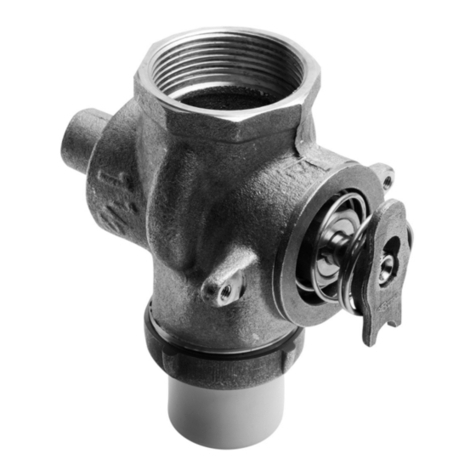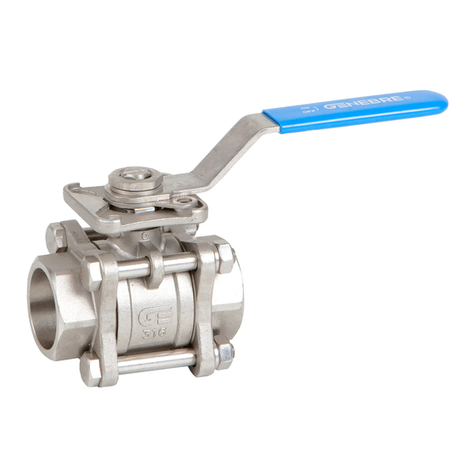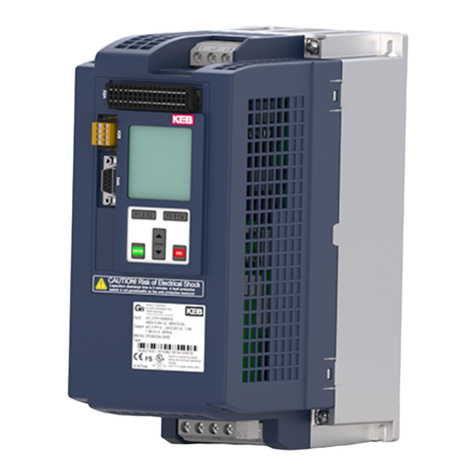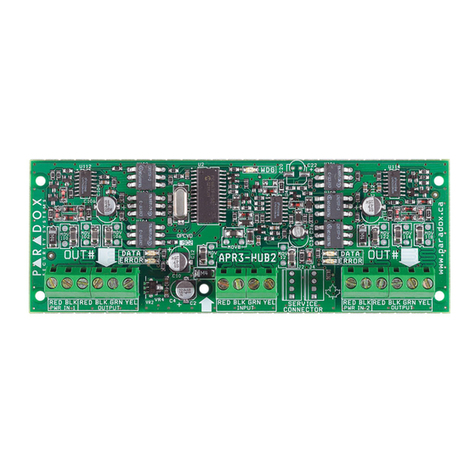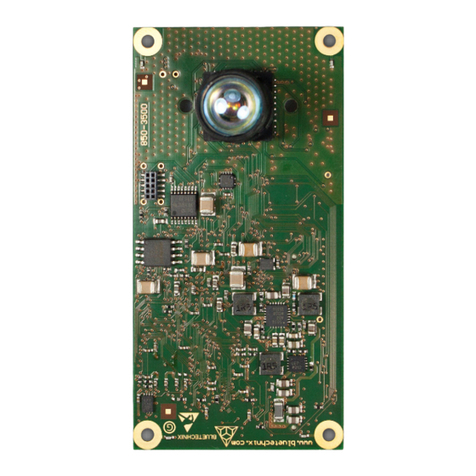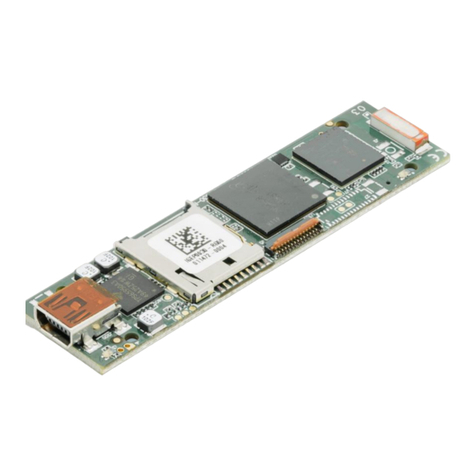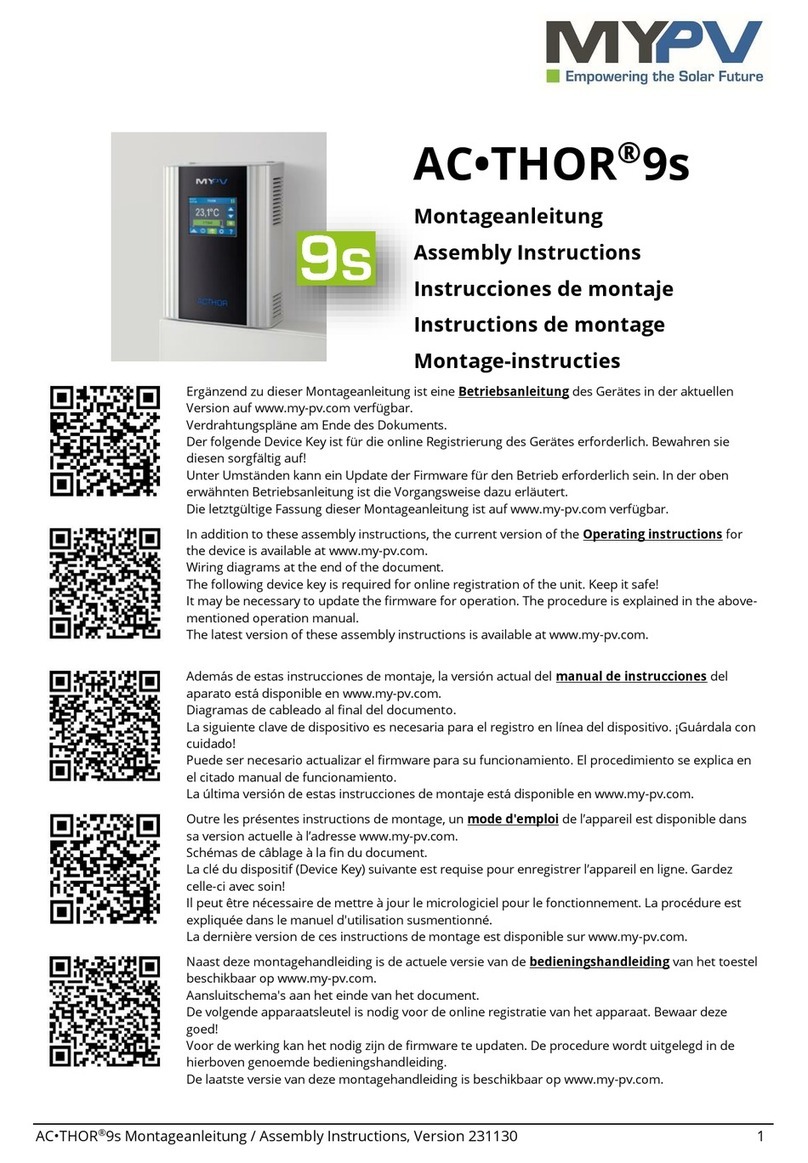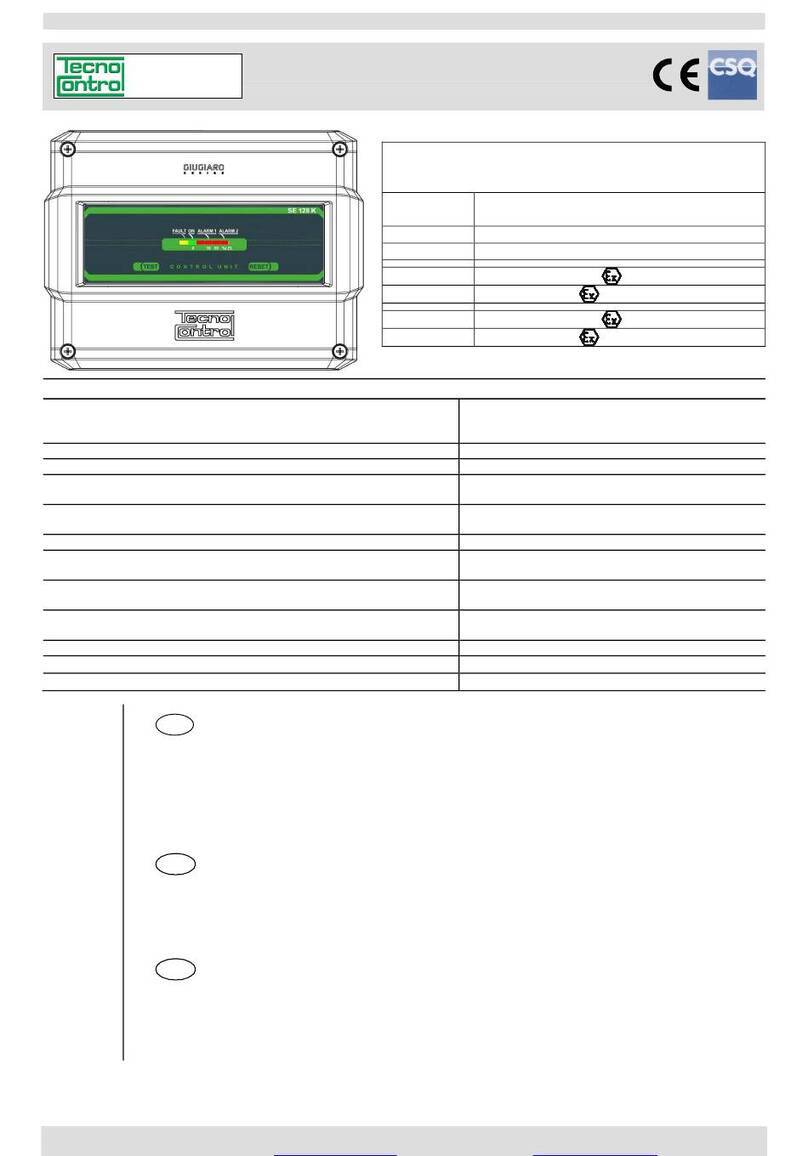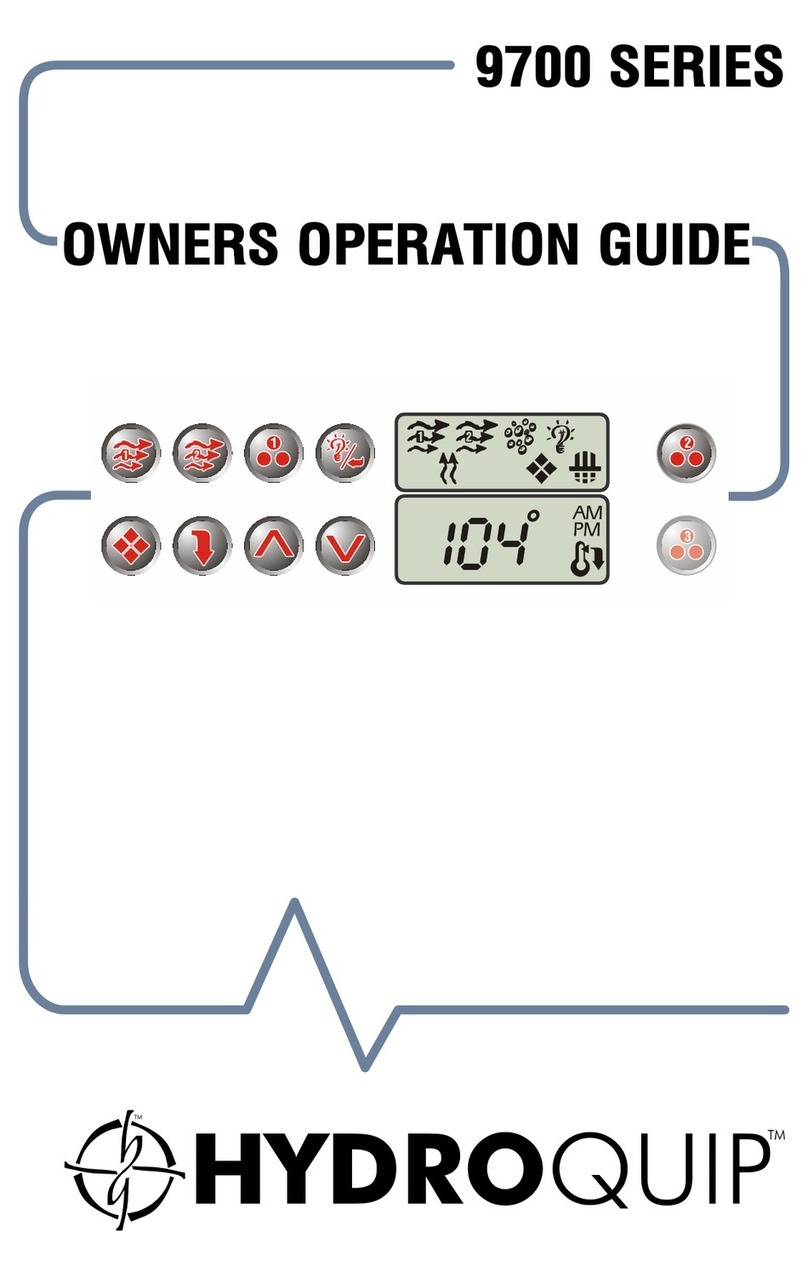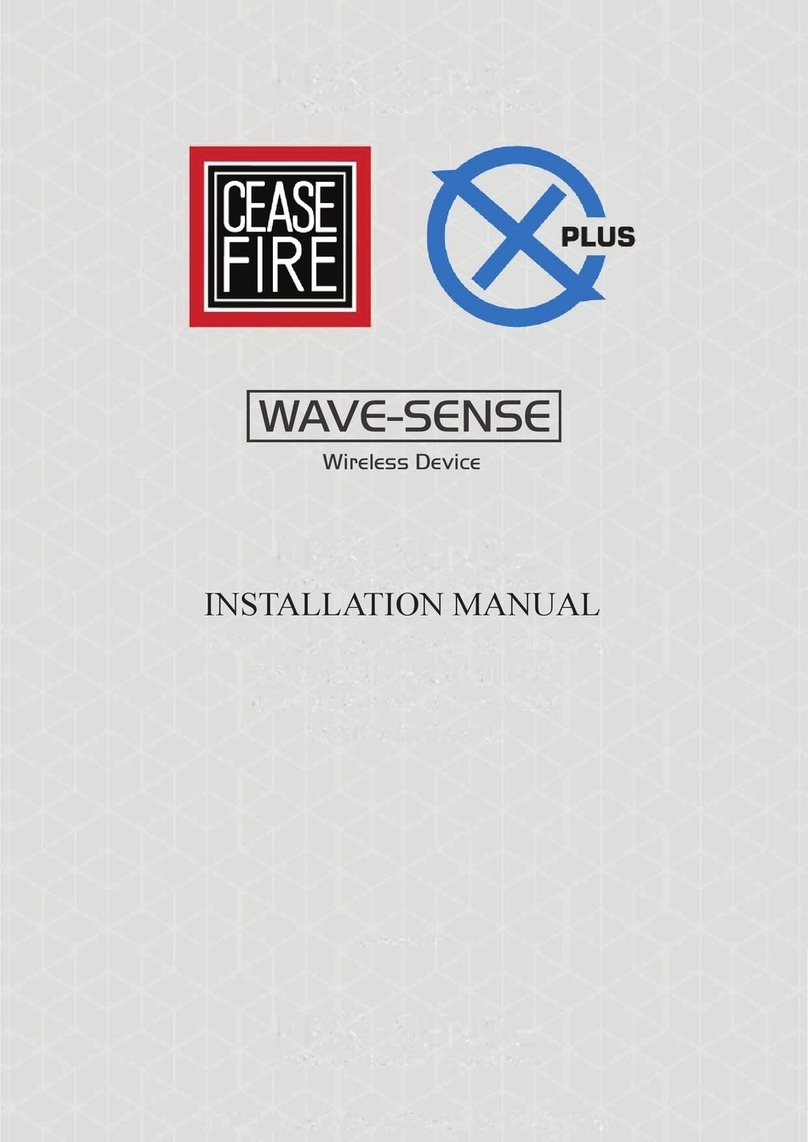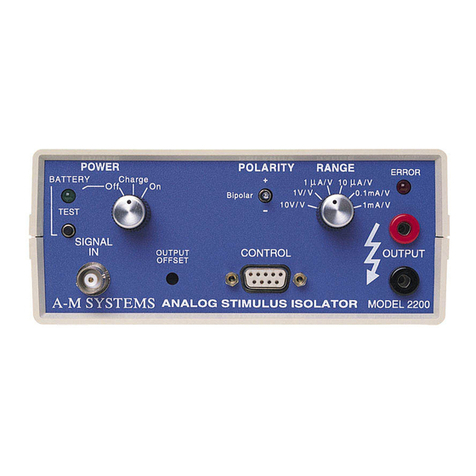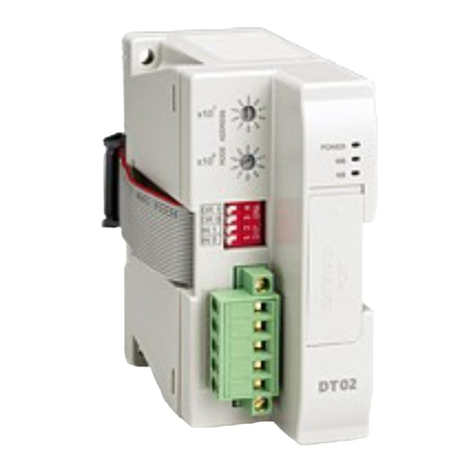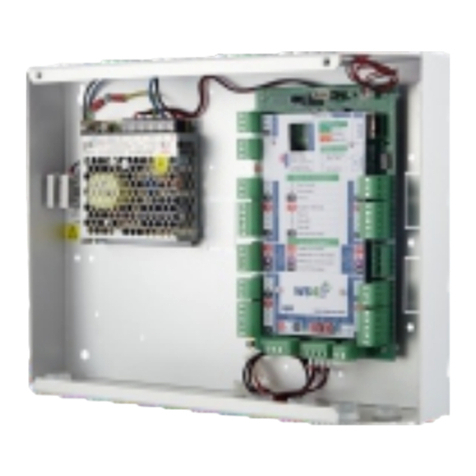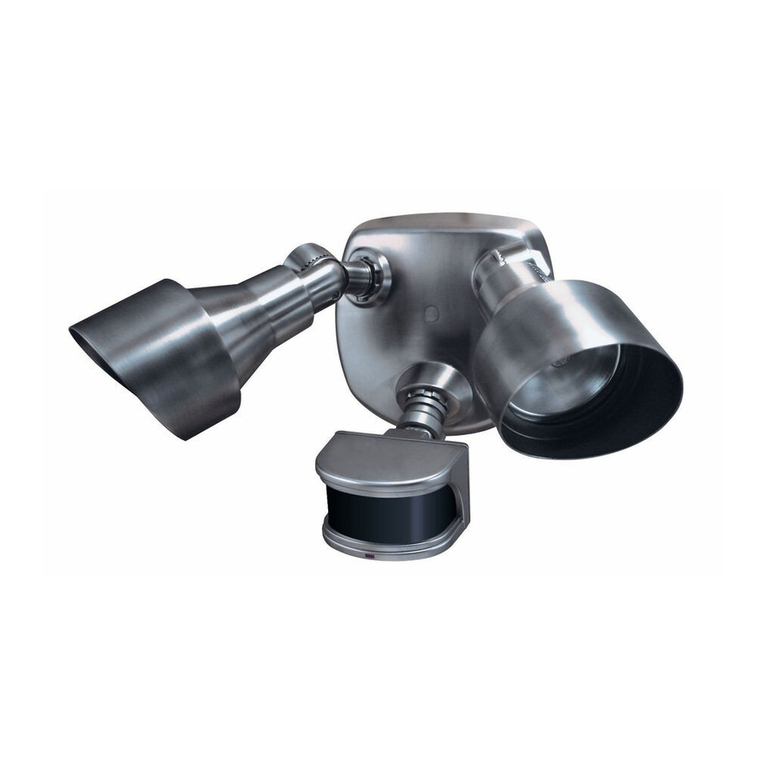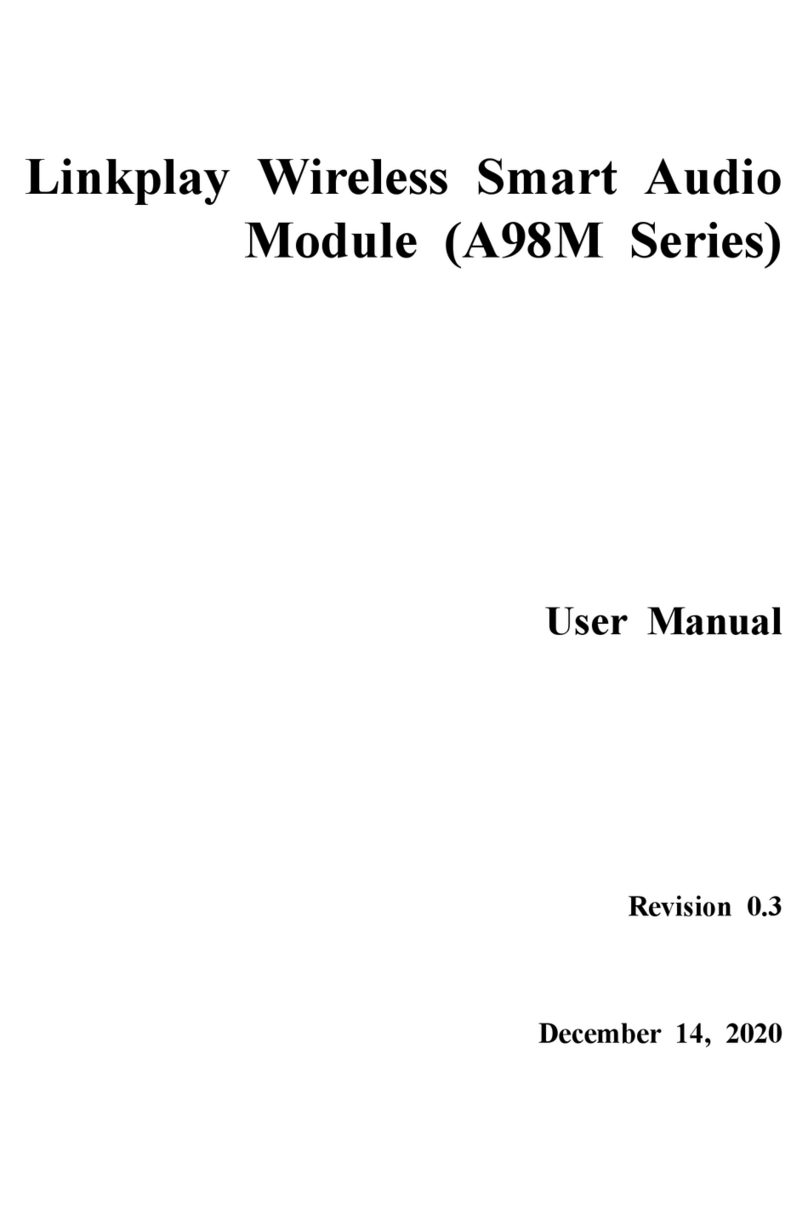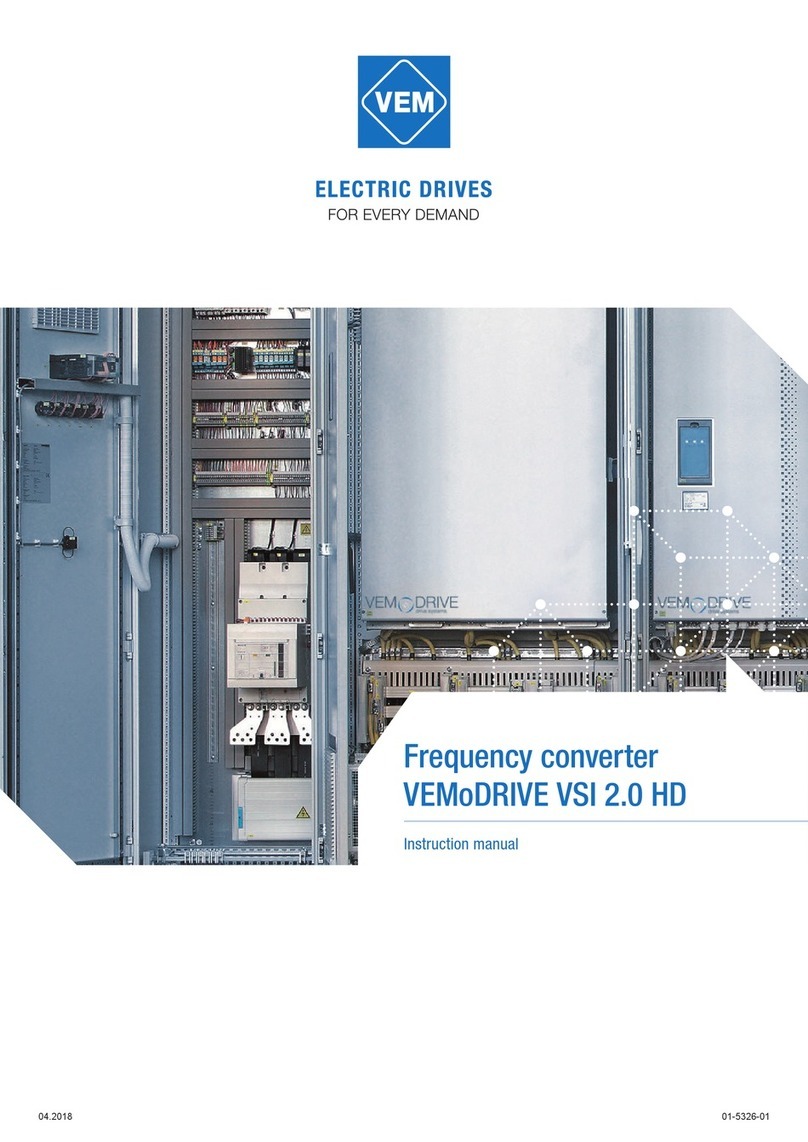Genebre 2040 User manual

Genebre Building. Av. de Joan Carles I, 46-48
08908 L'Hospitalet de Llobregat. Barcelona (Spain)
genebre@genebre.es - www.genebre.es
GENEBRE S.A.
LAST UPDATE: 17/08/2021 UPDATE NUMBER: 5
1
INSTALLATION, OPERATION AND MAINTENANCE
MANUAL
3 way ball valve "L" and "T" bore
threaded and flanged ends
Ref. GENEBRE: 2040–2040N–2041–2041N
2540–2541–2540E–2541E
2544–2545

Genebre Building. Av. de Joan Carles I, 46-48
08908 L'Hospitalet de Llobregat. Barcelona (Spain)
genebre@genebre.es - www.genebre.es
GENEBRE S.A.
LAST UPDATE: 17/08/2021 UPDATE NUMBER: 5
2
Installation, operation and maintenance instructions
1. Product description.....................................................................................................3
2. Transport and Storage conditions .............................................................................3
3. Valve breakdown..........................................................................................................4
3.1 Drawing and Components (Art. 2040 / 2041).........................................................................4
3.2 Drawing and Components (Art. 2540 / 2541).........................................................................5
3.3 Drawing and Components (Art. 2540E / 2541E / 2544 / 2545)..............................................7
4. Installation instructions ..............................................................................................8
4.1) Preparation .............................................................................................................................8
4.2) Assembling.............................................................................................................................8
5. Operating instructions ................................................................................................9
5.1) Usage......................................................................................................................................9
5.2) Manual operation....................................................................................................................9
6. Maintenance instructions..........................................................................................10
6.1) Stem leaks ............................................................................................................................10
6.2) Body/Cap gasket leakage .....................................................................................................10
6.3) Leakage in the line (through seats). .....................................................................................11
7. Reparation instructions.............................................................................................11
7.1) Disassembling ......................................................................................................................11
7.2) Reassembling .......................................................................................................................13
8. Torque table:..............................................................................................................15
9. Hygiene and Safety Instructions:.............................................................................16

Genebre Building. Av. de Joan Carles I, 46-48
08908 L'Hospitalet de Llobregat. Barcelona (Spain)
genebre@genebre.es - www.genebre.es
GENEBRE S.A.
LAST UPDATE: 17/08/2021 UPDATE NUMBER: 5
3
1. Product description.
Genebre, S.A. offers a wide range of ball valves (90º turn), designed and assembled to
handle and drive fluids in industrial procedures.
The compatibility of materials used to build the valves (see technical specifications) and
the application of valves to the different industrial processes is at user's risk. Valves will
have an optimal behavior when working conditions do not exceed pressure and
temperature limits (pressure curve) for which they have been designed. Please, refer to
the product datasheet.
2. Transport and Storage conditions
Transport and storage of this kind of products must be done keeping them in their
original package!
VISUAL INSPECTION
Check whether during transport, unloading and placement the products have suffered
damages.
During storage it is recommended to keep them into the included protective wrapping to
avoid damages or dirt accumulation in the ball. The wrap must not be removed until valve
is to be installed.
Valves must be stored in a dry and clean environment.
If you notice any kind of anomaly during reception of the goods, contact immediately
with GENEBRE in order to determine the possible responsibilities on the issue.

Genebre Building. Av. de Joan Carles I, 46-48
08908 L'Hospitalet de Llobregat. Barcelona (Spain)
genebre@genebre.es - www.genebre.es
GENEBRE S.A.
LAST UPDATE: 17/08/2021 UPDATE NUMBER: 5
4
IMPORTANT NOTE:
Before installing and/or manipulating these elements, READ CAREFULLY these
instructions for use and OBSERVE all contained information. If you fail to
understand any of their content, please contact GENEBRE, S.A.
User is responsible for the safe use of these products, according to present
instructions for use and specific technical documentation of the device.
3. Valve breakdown
3.1 Drawing and Components (Art. 2040 / 2041)

Genebre Building. Av. de Joan Carles I, 46-48
08908 L'Hospitalet de Llobregat. Barcelona (Spain)
genebre@genebre.es - www.genebre.es
GENEBRE S.A.
LAST UPDATE: 17/08/2021 UPDATE NUMBER: 5
5
Nº
Denominación / Name
Material
Acabado Superficial/
Surface Treatment
Cód. Recambio
Spare Part Code
1
Cuerpo / Body
Acero Inox. / Stainless Steel 1.4408
Granallado + Decapado /
Shot blasting + Pickling
------
2
Tapa / Cap
Acero Inox. / Stainless Steel 1.4408
Granallado + Decapado /
Shot blasting + Pickling
------
3*
Bola / Ball
Acero Inox. / Stainless Steel 1.4408
------
2840 "L" // 2841 "T"
4*
Asiento / Ball Seat
Teflón + 15% FV / PTFE + 15% FG
------
2819
5
Eje / Stem
Acero Inox AISI 316 / SS 316
------
------
6
Dispositivo Anti-estático /
Anti-Static device
Acero Inox AISI 316 / SS 316
------
------
7*
Anillo Fricción / Thrust Washer
PTFE
------
2819
8*
Tórica / O’ ring
FKM ( Viton)
------
2819
9*
Empaquetadura / Stem packing
PTFE
------
2819
10
Guarnición / Bushing
Inox. + PTFE / S.S. + PTFE
------
------
11
Anillo Prensa / Gland
Acero Inox AISI 304 / SS 304
------
------
12
Arandela Resorte / Spring Washer
Acero Inox AISI 301 / SS 301
------
------
13
Tuerca / Nut
ASTM A194-8
------
------
14
Antigiro / Nut Locker
Acero Inox AISI 304 / SS 304
------
------
15
Arandela / Washer
Acero Inox AISI 304 / SS 304
------
------
16
Tuerca Maneta / Handle Nut
Acero Inox AISI 304 / SS 304
------
------
17
Funda / Handle Sleeve
Vynil
------
------
18
Maneta / Handle
Acero Inox AISI 304 / SS 304
------
------
19
Bloqueo maneta / Lock device
Acero Inox AISI 304 / SS 304
------
------
20*
Junta / Gasket
PTFE
------
2819
21
Tornillo Tope / Stop Bolt
Acero Inox AISI 304 / SS 304
------
------
22
Tuerca / Nut
ASTM A194-8
------
------
* Available spare parts
3.2 Drawing and Components (Art. 2540 / 2541)

Genebre Building. Av. de Joan Carles I, 46-48
08908 L'Hospitalet de Llobregat. Barcelona (Spain)
genebre@genebre.es - www.genebre.es
GENEBRE S.A.
LAST UPDATE: 17/08/2021 UPDATE NUMBER: 5
6
Nº
Denominación / Name
Material
Acabado Superficial /
Surface Treatment
Cód. Recambio
Spare Part Code
1
Cuerpo / Body
Acero Inox. / SS 1.4408
Granallado / Shot blasting
------
2
Tapa / Cap
Acero Inox. / SS 1.4408
Granallado / Shot blasting
------
3*
Bola / Ball
Acero Inox. / SS 1.4408
------
B2540 "L" / B2541 "T"
4*
Asiento / Ball Seat
PTFE + 15% FV / GF
------
2928
5
Eje / Stem
Acero Inox. / SS AISI 316
------
------
6*
Anillo Fricción / Thrust washer
PTFE
------
2928
7*
Tórica / O’ ring
FPM (Viton)
------
2928
8*
Empaquetadura / Stem packing
PTFE
------
2928
9*
Casquillo / Bushing
Inox. + PTFE / S.S. + PTFE
------
2928
10
Anillo Prensa / Gland
Acero Inox / SS AISI 304
------
------
11
Arandela Resorte / Spring Washer
Acero Inox / SS AISI 304
------
------
12
Tuerca vástago / Stem Nut
Acero Inox / SS AISI 304
------
------
13
Antigiro / Nut Locker
Acero Inox / SS AISI 304
------
------
14
Arandela / Washer
Acero Inox / SS AISI 304
------
------
15
Maneta / Handle (DN25-DN50)
Acero Inox / SS AISI 304
------
------
16
Tapa ciega / End Cap
Acero Inox. / SS 1.4408
Granallado / Shot blasting
------
17
Bloqueo maneta / Lock device (DN25-DN50)
Acero Inox / SS AISI 304
------
------
18*
Junta / Gasket
PTFE
------
2928
19
Tornillo / Bolt
Acero Inox / SS AISI 304
------
------
20
Funda / Handle Sleeve
Vynil
------
------
21
Tornillo Tope / Stop Bolt
Acero Inox / SS AISI 304
------
------
22
Tuerca / Nut
Acero Inox / SS AISI 304
------
------
23
Adaptador Maneta / Handle Adapter
(DN65-DN100)
Acero Inox / SS AISI 304
Granallado / Shot blasting
------
24
Tornillo / Bolt
Acero Inox / SS AISI 304
------
------
25
Maneta / Handle
ASTM A 53
Cincado / Zn Plated
------
26
Funda / Handle Sleeve
Vynil
------
------
27
Tapa Inferior / Bottom Cap
Acero Inox / SS AISI 316
Granallado / Shot blasting
------
28*
Junta / Gasket
PTFE
------
2928
29
Tornillo / Bolt
Acero Inox / SS AISI 304
------
------
30*
Casquillo / Bush
PTFE
------
2928
31*
Disco / Disk
PTFE
------
2928
*Available spare parts

Genebre Building. Av. de Joan Carles I, 46-48
08908 L'Hospitalet de Llobregat. Barcelona (Spain)
genebre@genebre.es - www.genebre.es
GENEBRE S.A.
LAST UPDATE: 17/08/2021 UPDATE NUMBER: 5
7
3.3 Drawing and Components (Art. 2540E / 2541E / 2544 / 2545)
Nº
Denominación / Name
Material
Acabado Superficial /
Surface Treatment
Recambios /
Spare Parts
2540E / 2541E
2544 / 2545
1
Cuerpo / Body
Acero Inox. / SS 1.4408
Acero / Steel 1.0619
Granallado / Shot blasting
------
2
Tapa / Cap
Acero Inox. / SS 1.4408
Acero / Steel 1.0619
Granallado / Shot blasting
------
3*
Bola / Ball
Acero Inox. / Stainless Steel 1.4408
------
B2544 “L” /
B2545 “T”
4*
Asiento / Ball Seat
PTFE + 15% F.V. / PTFE + 15% G.F.
------
K2544
5
Eje / Stem
Acero Inox. / Stainless Steel AISI 316
------
------
6*
Anillo Fricción / Thrust washer
PTFE
------
K2544
7*
Tórica / O’ ring
FPM
------
K2544
8*
Empaquetadura / Stem packing
PTFE
------
K2544
9*
Dispositivo antiestático /
Antistatic device
Acero Inox. / Stainless Steel AISI 316
------
------
10
Anillo Prensa / Gland
Acero Inox. / Stainless Steel AISI 304
------
------
11
Arandela Resorte / Spring Washer
Acero Inox. / Stainless Steel AISI 301
------
------
12
Tuerca vástago / Stem Nut
Acero Inox. / Stainless Steel AISI 304
------
------
13
Antigiro / Nut Locker
Acero Inox. / Stainless Steel AISI 304
------
------
14
Arandela / Washer
Acero Inox. / Stainless Steel AISI 304
------
------
15
Maneta / Handle (DN25-DN50)
Acero Inox. / Stainless Steel AISI 304
------
------
16
Prisionero / Set Screw (DN65-DN100)
Acero Inox. / Stainless Steel AISI 304
------
------
17
Bloqueo maneta / Lock device (DN25-DN50)
Acero Inox. / Stainless Steel AISI 304
------
------
18*
Junta / Gasket
PTFE
------
K2544
19
Tornillo / Bolt
Acero Inox. / Stainless Steel AISI 304
------
------
20
Funda / Handle Sleeve (DN25-DN50)
Vynil
------
------
21
Tornillo Tope / Stop Bolt
Acero Inox. / Stainless Steel AISI 304
------
------
22
Tuerca / Nut
Acero Inox. / Stainless Steel AISI 304
------
------
23
Adaptador Maneta / Handle Adapter (DN65-DN100)
Acero Inox. / Stainless Steel 1.4308
Granallado / Shot blasting
------
24
Tornillo / Bolt (DN65-DN100)
Acero Inox. / Stainless Steel AISI 304
------
------
25
Maneta / Handle (DN65-DN100)
Acero Inox. / Stainless Steel AISI 304
------
------
26
Funda / Handle Sleeve (DN65-DN100)
Vynil
------
------
27
Tapa Inferior / Bottom Cap (DN65-DN100)
Acero Inox. / SS 1.4408
Acero / Steel 1.0619
------
28*
Junta / Gasket (DN65-DN100)
PTFE
------
K2544
29
Tornillo / Bolt (DN65-DN100)
Acero Inox. / Stainless Steel AISI 304
------
------
30*
Casquillo / Bush (DN65-DN100)
PTFE
------
K2544
31*
Disco / Disk (DN65-DN100)
PTFE
------
K2544

Genebre Building. Av. de Joan Carles I, 46-48
08908 L'Hospitalet de Llobregat. Barcelona (Spain)
genebre@genebre.es - www.genebre.es
GENEBRE S.A.
LAST UPDATE: 17/08/2021 UPDATE NUMBER: 5
8
*Available spare parts
4. Installation instructions
4.1) Preparation
Remove any material remains of the valve wrapping.
Serious problems may arise with the installation of a valve in a dirty pipe.
Make sure the pipe is not dirty and doesn’t have welding particles, for example, before
installing it. This may cause irreparable damages in the valve when the equipment is
started → prepare a clean working area.
Plan beforehand enough space for future maintenance operations.
Control correct operation of the valve by turning the handle clockwise and making sure
the ball closes the fluid flow. If this is not the case, check if there are foreign particles
inside the valve and repeat the whole operation.
In case of vibrations in the pipe it is strongly recommended to mount anti-vibration
elements to absorb them. Otherwise, the life of the product could be drastically reduced.
4.2) Assembling
- Art. 2040 / 2041 (valve with threaded ends)
Make sure the valve's pipe and thread end are clean and are compatible one with
another (type of thread end) Apply an appropriate sealing in the pipes' thread ends and
thread the valve being careful not to excessively tighten the conical threaded ends.
Do not use valve's handle as a lever to thread the valve into the pipe.
To tighten the valve it is recommended to use a spanner or monkey wrench only on the
hexagonal area of the valves edges, the torque applied being less than 30 Nm.
- 2540 (E) / 2541 (E) / 2544 / 2545 (valve with threaded ends)
Do not disassemble the valves for their installation.
Make sure the pipe's and edges flanges of the valve are clean.
Use the corresponding screws in all of the flanges drill holes.
Place an adequate joint in each end and align it in the center of the flanges.
Tighten screws evenly and cross-shaped to avoid deformations. To do so, you must not
force in any case the pipe to center the valve; it should take its position smoothly. Last,
verify that screws are tightened with the recommended torque for each type of screw.
Make sure the flanges' joints are well situated.
After assembling, check the tightness and performance of the valve.

Genebre Building. Av. de Joan Carles I, 46-48
08908 L'Hospitalet de Llobregat. Barcelona (Spain)
genebre@genebre.es - www.genebre.es
GENEBRE S.A.
LAST UPDATE: 17/08/2021 UPDATE NUMBER: 5
9
IMPORTANT INFORMATION:
The design of this type of 3-way ball valves with four seats allows us to install
them in any position as the fluid entrance can be any of the three.
If possible, it is recommended to install the valve in horizontal position and the
stem (handle) upwards.
Valves do not have to support pipe's efforts so it is advisable to anticipate a good
alignment and parallelism of such pipe.
Once installed, it is recommended to open and close it a couple of times to verify
its good knowledge and to check if there is any obstruction in the ball that
prevents it from closing.
It is also recommended to use filters in the pipes to extend lifecycle of the valve.
5. Operating instructions
5.1) Usage
Ball valves provide a leakproof lock when used adjusted to the pressure and temperature
values for which they have been designed.
Avoid by all means leaving the valves in partially open position if you are not aware of the
pressure drop and flow rate in that position, as the service life of the seat can be reduced
and/or it can be damaged due to the ball bore valve.
Seats for the valve, joints, body, ball, stem and ends have to be fully compatible with the
fluid circulating through the valve. Otherwise, the valve could be seriously damaged.
Torques required to operate valves are listed in the table Torques to activate the valves
(see Section 8.1).
5.2) Manual operation
When operating the valve you must avoid excessive lateral efforts with the handle.
In case you need to remove the handle to automate the valve, the stem (part 5) has a
mechanized linear mark at the front part (“L”or “T”shape) that allows us to know its
current position.

Genebre Building. Av. de Joan Carles I, 46-48
08908 L'Hospitalet de Llobregat. Barcelona (Spain)
genebre@genebre.es - www.genebre.es
GENEBRE S.A.
LAST UPDATE: 17/08/2021 UPDATE NUMBER: 5
10
5.3) Remote operation
When automation of the valves is required, GENEBRE S.A. can provide a great variety of
pneumatic actuators, electric actuators, electropneumatic and electronical positioners to
caps a large range of operations.
6. Maintenance instructions
Frequency, place and process of maintenance will be determined by the user by taking
into account usage of the product. However, periodical checks explained below will be
useful to extend the service life of the valve and reduce installation problems.
Valves must not remain in the same position for a long period of time. It is recommended,
if the process allows for it, to operate it for control purposes every six months.
6.1) Stem leaks
Remove the handle or actuator, the lock nut washer (part 14-Threaded / part 1-Flanged)
and tighten the nut (part 13-Threaded / part 12 Flanged) of the stem packing (see Section
8.2). If the leakage persists, valve should be disassembled to replace the stem washers
(parts 7,8,9,10-Threaded / parts 6, 7, 8, 9-Flanged).
See reparation instructions.
6.2) Body/Cap gasket leakage
- Art. 2040 / 2041 (valve with threaded ends)
Check if the caps (part 2) is tight. If it was loose, tighten it. If leak continues, it is probably
due to a damage int he body's joint or the locking surface, and it will be necessary to
disassemble the valve to repair it.
See reparation instructions.
- Art. 2540 (E) / 2541 (E) / 2544 / 2545 (valve with flanged ends)
Check if the body screws (part 21) are tightened. If they were loose, adjust them up until
the recommended torques (IMPORTANT: adjustment of such screws will have to be
done at room temperature). If leak continues, it is probably due to a damage int he body's
joint or the locking surface, and it will be necessary to disassemble the valve to repair it.
See reparation instructions.

Genebre Building. Av. de Joan Carles I, 46-48
08908 L'Hospitalet de Llobregat. Barcelona (Spain)
genebre@genebre.es - www.genebre.es
GENEBRE S.A.
LAST UPDATE: 17/08/2021 UPDATE NUMBER: 5
11
6.3) Leakage in the line (through seats).
Check if the valve entrance is in a completely closed position. If so, the leak is due to a
seat or locking surface being damaged and it will be necessary to disassemble the valve
for repairing it.
See reparation instructions.
7. Reparation instructions
7.1) Disassembling
You must remove the valve from the installation to repair it.
Prepare a clean working area and adequate tools to perform mechanical tasks.
- Art. 2040 / 2041 (valve with threaded ends)
a.- Loosen and remove the stoppers (part 2). Be careful not to damage the valve
surfaces.
b.- Once the stoppers are removed (part 2) remove the ball (part 3) being careful not to
damage it.
c.- Remove the seats (part 4) from their corresponding location inside the body and also
inside the stoppers.
d.- After this, remove the body's seat holders (part 20). They should be removed being
carefully not to scratch or damage the mechanized surfaces over which they are
hermetically sealed.
e.-To disassemble the stem (part 5), remove the following elements:
Before disassembling the pipe's valve to repair or replace it, make sure that line
has been closed and depressurized because a bad operational procedure could
cause a serious accident to staff and installation system

Genebre Building. Av. de Joan Carles I, 46-48
08908 L'Hospitalet de Llobregat. Barcelona (Spain)
genebre@genebre.es - www.genebre.es
GENEBRE S.A.
LAST UPDATE: 17/08/2021 UPDATE NUMBER: 5
12
Push the stem to the inside part of the body and remove it. Then, remove the washer
(part 10 and the packaging (part 9) located inside the body. Remove the o’ring (part 8)
from its location and the friction washer (part 7).
f.- Once the valve is disassembled you must verify the state of each single piece that
forms it. All pieces to be reused have to be cleaned completely and be kept in a safe and
clean environment.
All locking surfaces in the ball, seats, joints and sides have to be checked for corrosion,
erosion or metallic inlays in the seats and marks. If they were damaged or in case of
doubt, they will need to be replaced.
g.- Cleaning of the valve's pieces must be done using an adequate degreasing agent.
You must be careful with the locking surfaces, for example, of the ball, locking sides of
the stopper and joints, because if they were damaged this could cause a bad impact in
the valve's performance.
- 2540 (E) / 2541 (E) / 2544 / 2545 (valve with flanged ends)
a.- Loosen and remove the 4 screws (part 21) from each cap (part 2) and remove all the
caps. Be careful not to damage the edges surfaces.
b.- Remove the ball (part 3) being careful not to damage it.
c.- Extract the seats (part 4) from their corresponding location.
d.- After this, remove the caps's joints (part 18). They should be removed being carefully
not to scratch or damage the mechanized surfaces over which they are hermetically
sealed.
e.-To disassemble the stem (part 5), remove the following elements:
Name
Art. 2040 / 2041
Handle nut
Part 16
Handle
Part 18
Washer
Part 15
Nut Locker
Part 14
Stem nut
Part 13
Spring washers
Part 12
Gland
Part 11

Genebre Building. Av. de Joan Carles I, 46-48
08908 L'Hospitalet de Llobregat. Barcelona (Spain)
genebre@genebre.es - www.genebre.es
GENEBRE S.A.
LAST UPDATE: 17/08/2021 UPDATE NUMBER: 5
13
Push the stem to the inside part of the body and remove it. Then, remove the washer
(part 9) and the packaging (part 8) located inside the body. Remove the o’ring (part 7)
from its location and the friction washer (part 6).
f.- Once the valve is dismantled you must verify the state of each single piece that
compose it. All pieces to be reused have to be cleaned completely and be kept in a safe
and clean environment.
All locking surfaces in the ball, seats, joints and sides have to be checked for corrosion,
erosion or metallic inlays in the seats and marks. If they were damaged or in case of
doubt, they will need to be replaced.
g.- Cleaning of the valve's pieces must be done using an adequate degreasing agent.
You must be careful with the locking surfaces, for example, of the ball, locking sides of
the stopper and joints, because if they were damaged this could cause a bad impact in
the valve's performance.
7.2) Reassembling
Before proceeding to reassemble the valve, make sure that reparation kit and/or pieces
to be used are appropriate and original from the factory.
When it is armored again, cleaning is essential for a long life for the valve.
- Art. 2040 / 2041 (valve with threaded ends)
a.- Place a new friction washer (part 7) on the stem (part 5) and also the o’ring (part 8) in
its stem corresponding location, lubricate the stem with a thin layer of grease or silicon
(for example, Dow Corning 200) and insert it in the valve's body (part 1), in the internal
cavity, by pushing a bit to fix it.
b.- Place a new packaging (part 9) into its location in the upper cavity of the body (part 1),
the washer (part 10) the gland nut (part 11) and the spring washers (part 12 ) with
external borders together (concave position). Place the nut (part 13) and tighten it. Make
the stem turn a couple of times and readjust the nut respecting the torque specified
value (See Section 8.2).
If necessary, fasten with a wrench the internal body of the stem to tighten properly the nut
without making the stem turn.
Name
Art. 2540 (E) / 2541 (E) / 2544 / 2545
Handle nut
Part 12
Handle
Part 15 / Part 25
Washer
Part 14
Nut Locker
Part 13
Stem nut
Part 12
Spring washers
Part 11
Gland
Part 10

Genebre Building. Av. de Joan Carles I, 46-48
08908 L'Hospitalet de Llobregat. Barcelona (Spain)
genebre@genebre.es - www.genebre.es
GENEBRE S.A.
LAST UPDATE: 17/08/2021 UPDATE NUMBER: 5
14
It is convenient to match one of the nut vertex with one of the stem vertex to be able to
place later on the lock nut (part 14).
Note that if the nut is too tight, the rod torque will increase and service life of its elements
will be reduced.
c.- Place one of the seats (part 4) in the inside part of the body and the other three seats
in the caps's location.
c.- Place the stem in closed valve position and insert the ball (part 3) inside the body
cavity (part 1) matching the ball slot with the stem milling (part 5).
e.- Place the corresponding seat holders (part 20) on each one of the valve's stoppers
(part 2).
f.- Place the stoppers on the body and tighten them as much as possible.
It is required that the body and caps make contact in their metal sides.
- Art. 2540 (E) / 2541 (E) / 2544 / 2545 (valve with flanged ends)
a.- Place a new friction washer (part 6) on the stem (part 5) and also the o’ring (part 7) in
its stem corresponding location, lubricate the stem with a thin layer of grease or silicon
(for example, Dow Corning 200) and insert it in the valve's body (part 1), in the internal
cavity, by pushing a bit to fix it.
b.- Place a new packaging (part 8) into its location in the upper cavity of the body (part 1),
the washer (part 9) the gland nut (part 10) and the spring washers (part 11 ) with external
borders together (concave position). Place the nut (part 12) and tighten it. Make the stem
turn a couple of times and readjust the nut respecting the torque specified value (See
Section 8.2).
If necessary, fasten with a wrench the internal body of the stem to tighten properly the nut
without making the stem turn.
It is convenient to match one of the nut vertexes with one of the stem vertexes to be able
to place later on the lock nut (part 13).
Note that if the nut is too tight, the rod torque will increase and service life of its elements
will be reduced.
c.- Place the stem in closed valve position and insert the ball (part 3) inside the body
cavity (part 1) matching the ball slot with the stem milling (part 5).
d.- Place each one of the seats (part 4) on its corresponding location.

Genebre Building. Av. de Joan Carles I, 46-48
08908 L'Hospitalet de Llobregat. Barcelona (Spain)
genebre@genebre.es - www.genebre.es
GENEBRE S.A.
LAST UPDATE: 17/08/2021 UPDATE NUMBER: 5
15
e.- Terminals or caps (part 2) need to have locking parts cleaned before proceeding to
final assembly. Place each one of them in their corresponding position using the caps's
joints (part 18).
f.- Then, proceed to place the screws (part 21) adjusting slowly and alternating diagonal
and evenly until obtaining the recommended tightening torque (see Section 8.3).
8. Torque table:
8.1) Maximum torque values to operate the valves:
SIZE
Operating torque (N.m.)
2040 / 2041
2540 / 2541
2540E / 2541E
2544 / 2545
1/4”
8
***
***
3/8”
8
***
***
1/2"
8
***
***
3/4"
9
***
***
1”
18
21
20
1 ¼”
21
28
27
1 ½”
26
37
40
2”
36
51
47
2 ½”
55
81
75
3”
***
130
130
4”
***
220
240
REMARK: values measured without fluid after 24 hours without operating the valve.
8.2) Tightening torque for stem nut:
Following data is provided as reference only. Torques mentioned are the ones used to
activate the assembled stem before ball and seats are assembled.
Valve size
Torque value (N.m.)
1/4" - 3/8” -1/2"
6 - 9
3/4" -1”
8 - 12
1 ¼” -1 ½” -2”
13 - 18
2 ½” -3” -4”
19 - 24.5

Genebre Building. Av. de Joan Carles I, 46-48
08908 L'Hospitalet de Llobregat. Barcelona (Spain)
genebre@genebre.es - www.genebre.es
GENEBRE S.A.
LAST UPDATE: 17/08/2021 UPDATE NUMBER: 5
16
8.3) Tightening torque for screws/nuts that join body and caps.
It is required to contact metal to metal between body and caps.
Screw
Torque value (N.m.)
M6
8 - 11
M8
13.5 - 16
M10
22 - 25
M12
74.5 - 81
9. Hygiene and Safety Instructions:
9.1) Fluid passing through a valve or accessory can be corrosive, toxic, flammable or
pollutant. They can also be found at very high or low temperature. When operating
valves, you must follow the security instructions and it is recommended to use personal
protection gadgets:
1) Protect your eyes.
2) Wear gloves and appropriate working clothes.
3) Wear safety footwear.
4) Wear a helmet.
5) Have running water at hand.
6) To operate flammable fluids, make sure you have an extinguisher at hand.
Before removing a valve from a pipe, always check if the line is completely
drained and depressurized.
9.2) Operate the valve in open position to make sure there is no pressure in the internal
cavity.
9.3) Any valve being used by toxic services department needs to obtain a cleanliness
certificate before being operated.
9.4) Any type of repair or maintenance should be performed in ventilated places.
This manual suits for next models
9
Table of contents
Other Genebre Control Unit manuals

Genebre
Genebre 2103 User manual

Genebre
Genebre 2940 User manual

Genebre
Genebre 5985 User manual

Genebre
Genebre 2528V User manual

Genebre
Genebre 2406 User manual

Genebre
Genebre 2220 User manual

Genebre
Genebre 2102 User manual

Genebre
Genebre 2528A User manual
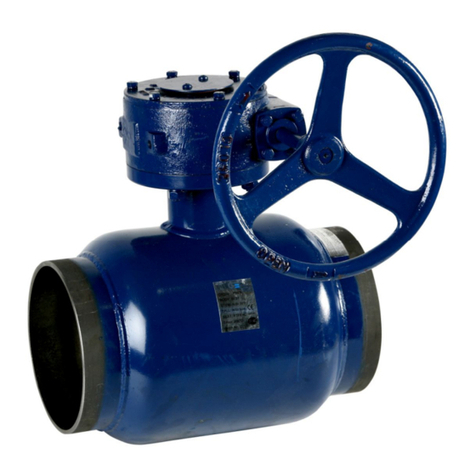
Genebre
Genebre 2035 Guide
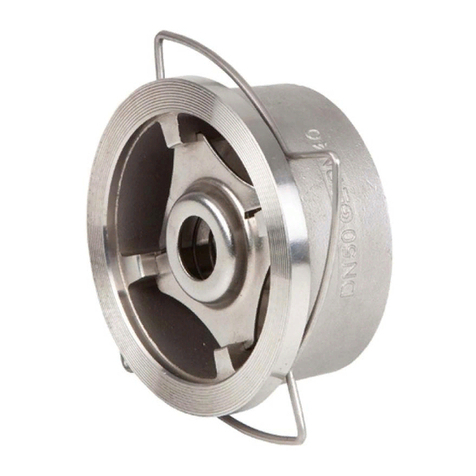
Genebre
Genebre 2415 User manual
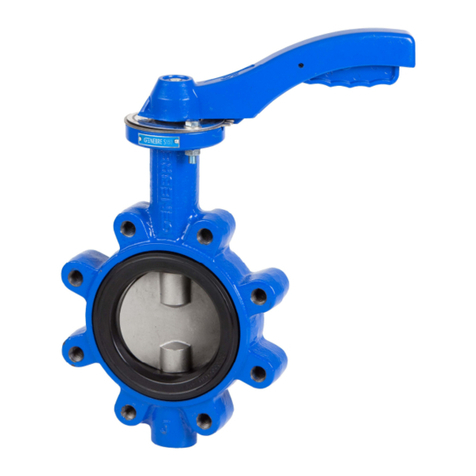
Genebre
Genebre 2108 User manual
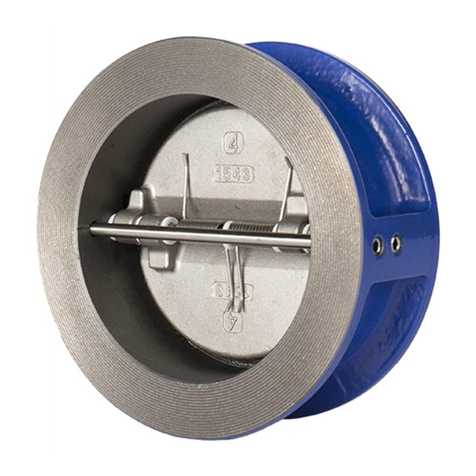
Genebre
Genebre 2402 Instruction manual

Genebre
Genebre 2232N User manual

Genebre
Genebre 2034 User manual

Genebre
Genebre 2233N User manual

Genebre
Genebre 2114 10 User manual

Genebre
Genebre V Series User manual

Genebre
Genebre 2105 User manual

Genebre
Genebre 2448 Instruction manual

Genebre
Genebre 2101 User manual


